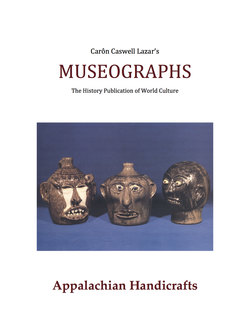Museographs: Appalachian Handicrafts

Реклама. ООО «ЛитРес», ИНН: 7719571260.
Оглавление
Caron Caswell Lazar. Museographs: Appalachian Handicrafts
Appalachian Handicrafts
The Traditional Crafts. Baskets
Blacksmithing
Chairmaking
Coverlets
Doll Making
Mountain Music and Handmade Instruments
Whittling and Wood Carving
Mary Frances Davidson and the Art of Vegetable Dyeing
A Brief Horticultural Guide to Color
Georgian Folk Pottery
The Meaders Pottery Clan
Mini Biographies. Bea Hensley
The Mace family
Edsel Martin
Edd Presnell
Alvin and Trevle Wood
Edsel Martin tells the Indian legend “Whence Came the Birds”
Special Thanks
Color Plates. Plate One. White Oak Egg or Shopping Basket
Plate Two. Andirons, Metal Chest and Assorted Tolls
Plate Three. Southern Highland Ladder-Back Chair
Plate Four. Traditional Coverlet Pattern Hanging
Plate Five. Mountain People
Plate Six. Handmade Dulcimer
Plate Seven. Southern Highland Carvings
Plate Eight. Three Brothers in Clay; Face Jugs
About the Author
Отрывок из книги
The first settlers to come to Appalachia came from the hills of Pennsylvania and from Virginia and North Carolina. These people, mostly of an English-Scottish-Irish origin, carried with them the strong handicraft cultures of their heritage. These skills were to become the basis of their lifestyle for well over a century without significant influence from beyond the mountains until the late 1890s. They came into the mountains with few possessions, only what was vital to make the trip as well as the occasional cherished article, heirloom or fine piece of furniture.
In the main they were far removed from trading routes and for the most part separated from the outside — although they were not entirely isolated since some of the mountain gaps were part of the westward migration route and as others came to Appalachia they brought with them knowledge of outside conditions. The people of Appalachia were isolated for reasons of economy as much as geography. For these reasons the mountain highland family produced virtually everything necessary for their family’s survival and comfort with their own hands. This independent way of life continued undisturbed until the end of the nineteenth century when some of the old crafts, like weaving, began a decline. This decline was in large measure due to greater availability of store-bought stuffs. It should be noted that for the most part the people of Appalachia continued to be independent well into the first quarter of the twentieth century.
.....
In the main they were far removed from trading routes and for the most part separated from the outside — although they were not entirely isolated since some of the mountain gaps were part of the westward migration route and as others came to Appalachia they brought with them knowledge of outside conditions. The people of Appalachia were isolated for reasons of economy as much as geography. For these reasons the mountain highland family produced virtually everything necessary for their family’s survival and comfort with their own hands. This independent way of life continued undisturbed until the end of the nineteenth century when some of the old crafts, like weaving, began a decline. This decline was in large measure due to greater availability of store-bought stuffs. It should be noted that for the most part the people of Appalachia continued to be independent well into the first quarter of the twentieth century.
However, in the late 1890s outside influences in the form of educated women missionaries and northern businesses began to make their way into the Highlands. As a result of the work of many women dedicated to a revival of traditional crafts as a means to economic prosperity, a number of fine institutions were established to promote and continue these skills. In the interest of space we will not deal with these institutions or their work, but rather will explore and describe the crafts themselves, some of the people who established them and some of those who continue the way of life even now.
.....